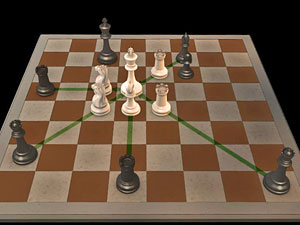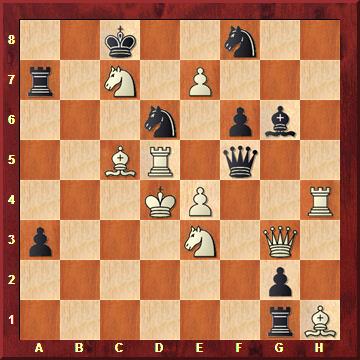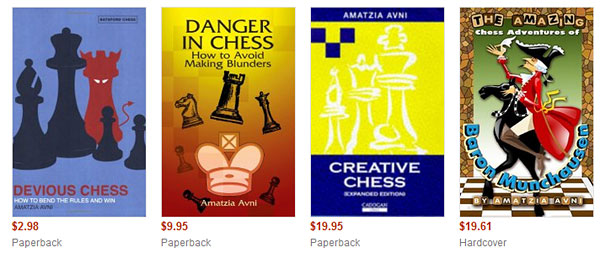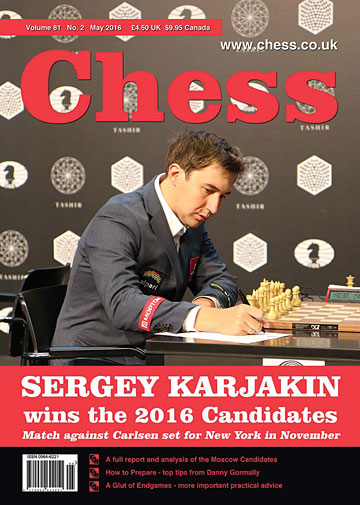


Young players are frequently unfamiliar with how chess was played in the pre-computer era. Nowadays it is hard to imagine starting a game without looking first for the opponent’s games in a database; to envisage a world where information from the latest tournament games played in distant countries took days, even weeks to travel. No Internet, no possibility of having in your fingertips an analysed verdict for all seven-piece positions, and a painstaking human home-analysis of tactical positions was required to reveal the truth. Presently chess software shortens the learning process of ambitious novices greatly. On the downside, there is a new fear that the opponent has used technology to cheat.
The age of computer chess is naturally discussed in professional literature. It ranges from guides indicating clever use of databases and engines (e.g. in John Nunn’s Secrets of Practical Chess, or Emil Vlasak continuous column ‘Computer News’ in the endgame magazine EG), to description of the concrete character of modern chess, where the software simultaneously raises the overall level and reduces personal differences of styles (Vladimir Tukmakov, in Modern Chess Preparation). Indeed, chess software has changed the game profoundly. “It’s night and day”, as Vishy Anand said in a 2015 interview.
The following piquant example might grant another taste of the gone forever, pre-computer era in chess.
A. Avni-I. Radashkovich, Israeli Championship, Tel Aviv 1978

The game was adjourned here, after five hours, with White to move. According to the tournament rules, there was an interval of 90 minutes before resumption.
My opponent seemed confident in his chances, hence when I suggested that we analyse the position together and act on the conclusions, he was happy to comply. We found some drawing lines, but in most cases Black gained the upper hand. Around 15 minutes before the planned resumption, my rival suddenly caught a terrible toothache to such an extent that the arbiter ruled that he should get urgent medical treatment and the conclusion of our game was postponed to the following night, after the next round.
I went home in a gloomy mood (the fact that I missed a quick victory on the 23rd move didn’t help), and upon arriving set the pieces on the board. Literally within a minute or two – it was the first variation I looked at – salvation was found. A draw.
The following night play resumed and it followed the path I had found. It transpired that Radashkovich made the same discovery and the following long sequence took perhaps just three minutes to play:

[Event "Israeli Championship, Tel Aviv"] [Site "?"] [Date "1978.??.??"] [Round "?"] [White "Avni, A."] [Black "Radashkovich, I."] [Result "1/2-1/2"] [ECO "D05"] [Annotator "Amatzia Avni"] [SetUp "1"] [FEN "8/8/8/1p1bk3/pP6/P1P1KP2/6P1/8 w - - 0 1"] [PlyCount "23"] [EventDate "1978.??.??"] [Source "ChessBase"] [SourceDate "2012.03.16"] 1. g4 Ba2 2. f4+ Kd5 3. f5 Kc4 $2 (3... Ke5 4. Kd3 Bb1+ ({or} 4... Kf4 5. Kd4 Kxg4 6. Kc5 Bc4 7. f6) 5. Ke3 Be4 6. c4 $1 bxc4 7. b5 {draws, as the advance of the b- and f-pawns will eventually force Black to abandon his c-pawn and thus be left with the 'wrong' bishop.}) 4. g5 Kxc3 5. g6 Bb1 6. Kf4 Kd4 7. Kg5 Ke5 8. f6 Ke6 9. f7 Ke7 10. Kh6 Kf8 11. Kh7 Bd3 12. Kh8 $1 {[%csl Rh7][%cal Rd3g6] Of course ...Bxg6 is stalemate.} ({Black was praying for} 12. Kh6 $2 Bc4 13. Kh7 Bxf7) 1/2-1/2
It looks nice, almost a prepared endgame study. However, let’s get back to the position after Black’s 44th move.

[Event "Israeli Championship, Tel Aviv"] [Site "?"] [Date "1978.??.??"] [Round "?"] [White "Avni, A."] [Black "Radashkovich, I."] [Result "1/2-1/2"] [ECO "D05"] [Annotator "Amatzia Avni"] [SetUp "1"] [FEN "8/8/8/1p3P2/pPk3P1/P1P1K3/b7/8 w - - 0 45"] [PlyCount "28"] [EventDate "1978.??.??"] [SourceDate "2016.04.22"] {Black's last move (44...Kd5-c4?)) was actually a serious error, after which he not only abandoned all hopes of victory, but came very close to losing the game. A quick glance at Fritz reveals the move} 45. f6 $1 {This seems to gain the upper hand, but after} Kxc3 46. Kf4 Kb2 47. g5 Kxa3 48. g6 Kb2 49. f7 { , Black is saved miraculously with} a3 50. f8=Q Bc4 {and in spite of a huge material advantage, White is unable to convert. One amusing line is} 51. Qf6+ Kb1 52. Qf5+ Kb2 53. Qe5+ Kb1 54. Qe4+ Kb2 55. Qd4+ Kb1 56. Qxc4 bxc4 57. g7 c3 58. g8=Q Kb2 {with a draw.} 1/2-1/2
The fact that two reasonable players ignored 45 f6 in home analysis is strange enough, but then consider this: the endgame was published at the time in Informator 26, in the Encyclopaedia of Chess Endings, in Speelman’s Endgame Preparation; in Kostyev’s From Beginner to Expert in 40 Lessons, and there might be other publications that I am not aware of. None of the editors/authors pointed the possibility of 45 f6.
Now, some 40 years later, such occurrence can never repeat itself, for:
There are no adjournments.
Nobody aided by chess software will make analytical mistakes at home.
No one using a silicon monster will publish or copy such an episode without noticing the 45 f6 line.
Comparing home analysis of adjourned games to home analysis in opening preparation, most players will just follow the software evaluations. Thus, they will miss the pretty variation which occurred in the game altogether, because the computer will dismiss 44...Kc4. Ah, those were the days.
Software and databases have also changed the way studies are composed. In the (good?) old days the composer would sit in front of a board and pieces. Now the majority of composers will not use a chess set, but handle the creative process on a computer screen, with Fritz and co. giving them immediate, often conclusive judgement on each shift of pieces and change of material.
In Harold van der Heijden’s database for endgames, it is common to find old studies with several versions. The composer published a study, it was demolished by solvers, so the composer expressed his idea in another setting – still faulty. Another try, and so on. An incredible amount of studies in the pre-computer era were unsound, whereas in modern endgame tourneys such instances have been reduced to a minimum.
A great leap forward has been witnessed in the last decade and a half, in both the level and accuracy of prize-winning studies. Being able to quickly find the verdict of almost any setting you put on the board has facilitated the art of creation, enabling composers to implement bold, breathtaking ideas.
Darko Hlebec, Baku Chess Olympiad ty. 2016, Special Prize

Black to play, White draws
Readers who play through the solution will feel immediately the involvement of a computer. A most unnatural position, a series of strange, sometimes incomprehensible moves, which are designed to lead to a final, unbelievable five-pin stalemate. A composer would hardly succeed at creating such a daring concept if he hadn’t electronic supervision at each step of building the grandiose scheme.

[Event "SP, Baku Chess Olympiad ty."] [Site "?"] [Date "2016.??.??"] [Round "?"] [White "Hlebec, D."] [Black "?"] [Result "1/2-1/2"] [Annotator "Amatzia Avni"] [SetUp "1"] [FEN "2k2n2/r1N1P3/3n1pb1/2BR1q2/3KP2R/p3N1Q1/6p1/6rB b - - 0 1"] [PlyCount "21"] [EventDate "2016.??.??"] [SourceDate "2016.04.22"] {Readers who play through the solution will feel immediately the involvement of a computer. A most unnatural position, a series of strange, sometimes incomprehensible moves, which are designed to lead to a final, unbelievable five-pin stalemate. A composer would hardly succeed at creating such a daring concept if he hadn't electronic supervision at each step of building the grandiose scheme.} 1... Ne6+ $1 2. Nxe6 Qxe4+ $1 3. Rxe4 a2 4. e8=Q+ Bxe8 5. Rxd6 a1=Q+ 6. Kd5 Qa2+ 7. Nc4 Rd1+ 8. Bd4 Ra5+ 9. Nc5 Bf7+ 10. Rde6 gxh1=Q 11. Qc7+ $3 Kxc7 {[%cal Gh1d5,Gd1d5,Ga2d5,Ga5d5,Gf7d5] [#] A truly amazing stalemate.} 1/2-1/2
 |
Amatzia Avni, 61, is a FIDE Master in both over-the-board chess and composition. A psychologist by profession, he works as a lecturer on behavioral topics and in the field of personnel selection. Avni is an occasional contributor to chess magazines and websites. Over the years he has written several acclaimed books, his best being "The amazing chess adventures of Baron Munchausen" (Mongoose Press, 2011), a collection of pieces he wrote for the British "Chess" magazine for ten years. Fide "Chess in Schools" translated three episodes from the book into ten languages. Amatzia lives in Israel; married, with three children and one granddaughter. |

Books by Amatzia Avni available in Amazon
The above article appeared in the April 2016 of the British magazine CHESS

CHESS Magazine was established in 1935 by B.H. Wood who ran it for over fifty years. It is published each month by the London Chess Centre and is edited by IM Richard Palliser and Matt Read. The Executive Editor is Malcolm Pein, who organises the London Chess Classic.

CHESS is mailed to subscribers in over 50 countries. You can subscribe
from Europe and Asia at a specially discounted rate for first timers here.